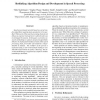Free Online Productivity Tools
i2Speak
i2Symbol
i2OCR
iTex2Img
iWeb2Print
iWeb2Shot
i2Type
iPdf2Split
iPdf2Merge
i2Bopomofo
i2Arabic
i2Style
i2Image
i2PDF
iLatex2Rtf
Sci2ools
89
Voted
ICPR
2010
IEEE
2010
IEEE
Rethinking Algorithm Design and Development in Speech Processing
Speech processing is typically based on a set of complex algorithms requiring many parameters to be specified. When parts of the speech processing chain do not behave as expected, trial and error is often the only way to investigate the reasons. In this paper, we present a research methodology to analyze unexpected algorithmic behavior by making (intermediate) results of the speech processing chain perceivable and intuitively comprehensible by humans. The workflow of the process is explicated using a real-world example leading to considerable improvements in speaker clustering. The described methodology is supported by a software toolbox available for download.
Computer Vision | ICPR 2010 | Speech Processing | Speech Processing Chain | Unexpected Algorithmic Behavior |
Related Content
| Added | 13 May 2010 |
| Updated | 13 May 2010 |
| Type | Conference |
| Year | 2010 |
| Where | ICPR |
| Authors | Thilo Stadelmann, Yinghui Wang, Matthew Smith, Ralph Ewerth, Bernd Freisleben |
Comments (0)

